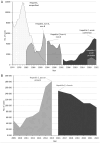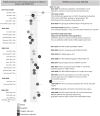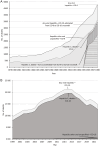Hepatitis C Surveillance in the United States: Past, Present, and Future
- PMID: 40874425
- PMCID: PMC12394212
- DOI: 10.1177/00333549251351880
Hepatitis C Surveillance in the United States: Past, Present, and Future
Abstract
Data from 3 US public health surveillance systems indicate that an estimated 67 400 people acquired hepatitis C virus infections in 2022, 2.2 million adults had hepatitis C during January 2017-March 2020, and 12 717 people died in 2022 from hepatitis C-related causes, despite the availability of curative treatment since 2013. The 3 surveillance systems that provided these data-the National Notifiable Diseases Surveillance System, the National Health and Nutrition Examination Survey, and the National Vital Statistics System-were selected to monitor progress toward elimination of hepatitis C as a public health threat in the United States by 2030. However, some limitations of these surveillance systems compel the use of additional data sources with more timely information for the general population and for populations with higher incidence, prevalence, or mortality of hepatitis C, such as those experiencing homelessness, incarceration, or injection drug use. Commercial laboratories, health systems, and programs serving these populations could provide such data. This topical review of hepatitis C surveillance describes the history, long-term trends, and recent investments in public health surveillance for hepatitis C. Strengthening and modernizing the hepatitis C surveillance workforce and systems, improving data system interoperability, linking complementary data sources, and leveraging multiple data systems can aid in the measurement of public health efforts to meet hepatitis C elimination goals.
Keywords: data modernization; hepatitis C; public health; surveillance; trends.
Conflict of interest statement
The authors declared no potential conflicts of interest with respect to the research, authorship, and/or publication of this article.
Figures



References
-
- Centers for Disease Control and Prevention. Viral hepatitis surveillance report—United States, 2022. April 2024. Accessed April 26, 2024. https://www.cdc.gov/hepatitis-surveillance-2022/about/index.html
-
- Centers for Disease Control and Prevention. What is case surveillance? Last reviewed November 20, 2024. Accessed July 11, 2024. https://www.cdc.gov/nndss/what-is-case-surveillance/index.html
-
- Centers for Disease Control and Prevention. About NHANES. Last reviewed December 18, 2024. Accessed May 24, 2024. https://www.cdc.gov/nchs/nhanes/about/index.html
-
- National Center for Health Statistics. About the National Vital Statistics System. Last reviewed January 4, 2016. Accessed May 12, 2023. https://www.cdc.gov/nchs/nvss/about_nvss.htm
Publication types
LinkOut - more resources
Full Text Sources
Miscellaneous

